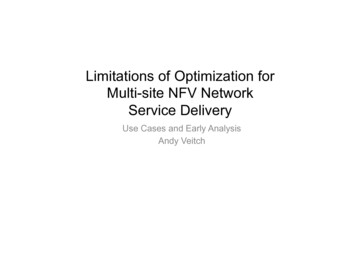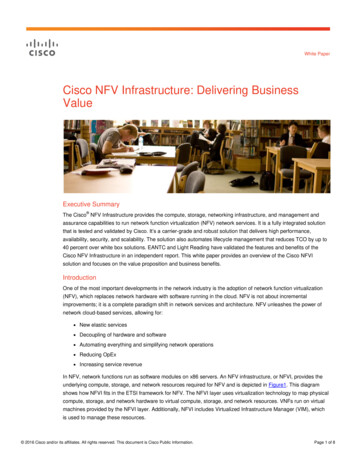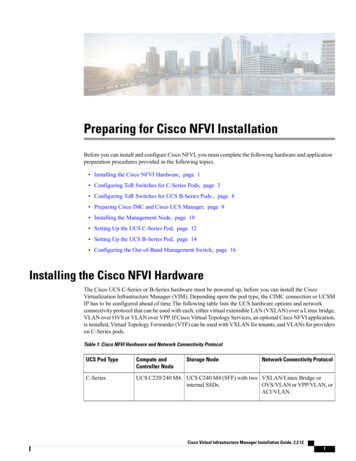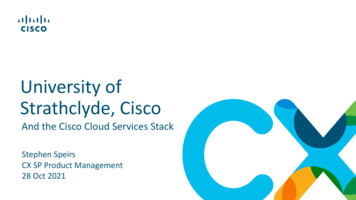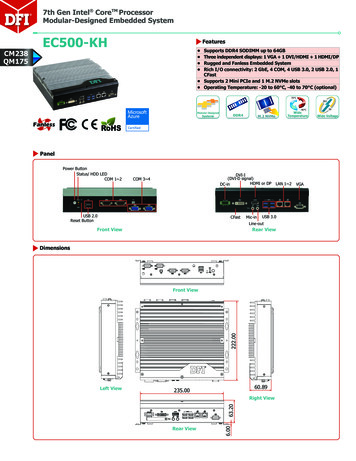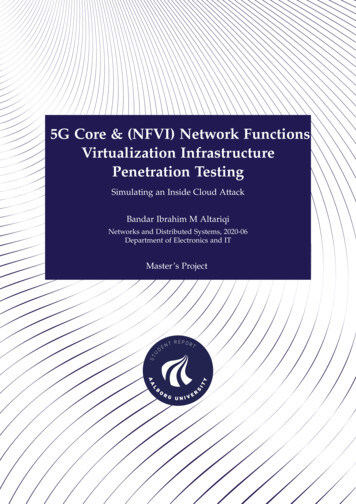
Transcription
5G Core & (NFVI) Network FunctionsVirtualization InfrastructurePenetration TestingSimulating an Inside Cloud AttackBandar Ibrahim M AltariqiNetworks and Distributed Systems, 2020-06Department of Electronics and ITMaster’s ProjectSTUDENT REPORT
Copyright c Aalborg University 2020
Electronics and ITAalborg Universityhttp://www.aau.dkTitle:5G Core and NFVI Network Functions Virtualization Infrastructure Penetration TestingTheme:Project ThemeProject Period:Spring Semester 2020Participant(s):Bandar Ibrahim M AltariqiSupervisor(s):Professor Tatiana Madsen [AAU]Lars Nielsen (Mikkelsen) [Keysight]Andrea Cattoni [Keysight]Copies: 1Page Numbers: 52Date of Completion:June 14, 2020Abstract:This project is a master thesis in collaboration with Keysight Technologies in Denmark. It aims to test 5G core (NFVI)components by penetration from inside thecloud with the goal of discovering theworst-case scenario (the cloud out of service). It also studies the topic from an attacker’s point of view, where the attackermight have infected some components, orvulnerability might be present, allowing anattacker to get in. To simplify, I basicallydonate it as an attacker and assume thatthe attacker is in place. The testing, asassumed, starts from an infected VM, andthen identifies the target component with ascan tool like "nmap". And finally, it usesdifferent attack tools to launch the attacks.Also, this project utilizes a variety of attack tools to test cloud security by examining firewalls and intrusion detection systems if they can identify malicious trafficfrom legitimate traffic. These tests wereperformed in two different clouds, a localcloud that is more development and sandbox oriented, and a remote cloud that’s focused on deploying a 5G core that is closeto production and with more robust security. Using smart attack tools, I was successfully able to attack some critical components that make the cloud in a denial ofservice state, even though a firewall/IDSwas in place during the tests. As a solution, middleware is needed to separate theinfrastructure’s components from the restof the cloud by deploying a firewall/IDSwith load-balancer to prevent attacks fromreaching any critical entity.
Contents1Introduction12State of the Art2.1 The Architecture of 5G Core . . . . . . . . . . . . . . . . .2.2 Network Functions Virtualization Infrastructure (NFVI)2.2.1 OpenStack . . . . . . . . . . . . . . . . . . . . . . .2.2.2 Kubernetes . . . . . . . . . . . . . . . . . . . . . .2.2.3 NGINX . . . . . . . . . . . . . . . . . . . . . . . . .334567.3Problem Statement4Existing Approaches115Methodology5.1 Scenarios . . . . . . . . . . . . .5.2 Targets . . . . . . . . . . . . . .5.2.1 OpenStack Keystone . .5.2.2 Kubernetes API Server .5.2.3 NGINX API Gateway .5.3 Test Equipment . . . . . . . . .5.3.1 Target IP Discovery . . .5.3.2 Attack Tools . . . . . . .5.4 System Design (TestBed) . . . .5.4.1 Local Cloud . . . . . . .5.4.2 Remote Cloud . . . . . .131314141415161617202022.25252528303469.Test Implementation & Results6.1 Local Cloud . . . . . . . . . . . . . . . . . . .6.1.1 Keystone on Local Cloud . . . . . . .6.1.2 Kubernetes Ingress on Local Cloud .6.1.3 NGINX for K8s on Local Cloud . . .6.1.4 pfSense Firewall Test on Local Cloudv.
viContents6.26.36.1.5 pfSense Firewall with Snort IDSRemote Cloud . . . . . . . . . . . . . . .6.2.1 Discovering the Targets . . . . .6.2.2 Testing . . . . . . . . . . . . . . .Summary of Test Results . . . . . . . . .35373738427Suggestions458Conclusion, Summary and Future Work49Bibliography51
PrefaceThis thesis focuses on the core security of 5G cloud, including the standard cloud, as theyboth share most of the infrastructure components. Clouds are multi-tenant or or multi-userwhich means that the same resources are shared by all. If one component becomes at adenial of service state, then most users of the cloud will be affected. This idea encouragedme to think and perform an in-depth search to find out the actual outcome in case there isan inside attack on the cloud.This report would not have existed without the help and support from Keysight Technologies in Denmark. I genuinely thank the security team, Lars Nielsen and Andrea Cattoni,for giving me full access to their labs, tools, and resources, and each of whom has providedme valuable advice and guidance throughout the research process.Special thanks are due to my supervisor, professor Tatiana Madsen "Aalborg University"for following-up, support, and supervision which helped me discover the best ways tosucceed in my studies.vii
Chapter 1IntroductionHuman need for faster network speed with low latency and high availability has increasedmultifold in the past few years. To address this exigency, Information and communicationstechnology industry has given a 5G network solution that is capable of handling high-speeddata, enabling the machine-to-machine communication at low latency, on-demand, highlycustomized networks, and auto-scaling [8]. Unlike its predecessor 4G where vendors usedto develop telecom applications which were designed to run on the proprietary hardwareprovided by the same vendor. Whereas, 5G has application/software (called Network Functions) made by one company, running over the hardware of another company, to make asolution that is used by some third company.In earlier network technologies, network scaling is a time-taking and complex task whichincreases the operating expense of providers, whereas in 5G networks with the help of autoscaling, the network, software and resources can be scaled-up and down according to theneed and situations [8]. 5G provides a considerable degree of flexibility and scalability tothe industry of information and communications technology. The 5G Core, in particular, hasa multitude of storage, processors, and networks, which is an accessible on-demand basis,and the customers share these resources to run their applications.5G networks will bring new models of how the services, infrastructure, and networks arebeing provided [2]. The use of virtualization, performance, and network slicing or zoningwill be the cornerstone in service delivery of the 5G cloud [2]. The 5G cloud is a novel technology and is still evolving with time. The swift acceptance and deployment of the 5G coreleave many security risks untested and unaddressed [21]. To identify the security risks andsecurity factors, security testing plays an important role [21]. It can help to uncover systemvulnerabilities, thus leading to improvement of system security from malicious actions ofintruders.This document aims to devise an approach that would help testing the 5G core & NFVI1
2Chapter 1. IntroductionNetwork Function Virtualization Infrastructure components and identify any possible security issues continuously during deployment, integration and development, as an update toa component might expose some vulnerability that did not previously exist. With such a bigand complex system as NFVI uses hypervisor and virtual infrastructure manager (OpenStack) to transfer hardware resources to be utilized and shared virtually with componentscalled VNFs Virtual Network Functions, and these are software packages that can providenetwork functions or services using the infrastructure of NFV Network Functions Virtualization [18], it is impossible to cover all parts of the core & NFVI in terms of vulnerabilitiesand security issues. Instead, it would be more beneficial to test and approach it from anattacker’s point of view, where the attacker might have infected some components or that avulnerability might be already present, allowing an attacker to access it. We do not discussin detail how such access can be obtained in practice, but our investigations are based onthe assumption that an attacker has access to some components in the cloud.The goal of this project is to define a methodological approach with which most of thesecurity risks can be identified and tested before they become a threat to the cloud. AtKeysight technologies in Denmark, we deployed a local cloud in a test environment, wherewe test all the most important components that have been used in the 5G core for mostpossible weaknesses using different tools mixed between simple open-source scripts thatare written in python or Go, and a powerful tool that is designed for penetration testingand works out most of the weaknesses that can be addressed before live deployment. Afterreaching a first impression of testing the local cloud, the next step is to use these methodsand tools on a 5G cloud that is close to production.
Chapter 2State of the ArtIn this section, we provide an overview of the 5G core, its infrastructure’s components, andsecurity and why it is different from previous generation. The following sections investigatethe present state of the art, as well as look at the main components that the cloud usesto deliver reliable services. This will help build up a picture of the present scene andwhich strategies and advances are valuable to take care of any current issue. The theoreticalfindings will be utilized for later tests and solutions.2.1The Architecture of 5G CoreThere are many expectations regarding 5G wireless technology which is expected to offera seamless worldwide experience. 5G technology is still in evolution and its specificationsthat have been described by 3GPP are not yet finalized [18]. Every new development inthis technology accumulates additional efficiency, capability, application cases in differentscenarios, in which the 5G network architecture packet, switching and network slicing areutilized to achieve higher efficiency [18].5G core architecture has the vision to increase and have the widest range of applicationsand services in the history of mobile wireless communications [19]. New applications of5G can be divided into three categories namely enhanced mobile broadband (eMBB), UltraReliable and Low Latency Communications (URLLC) and Massive Machine Type Communications (mMTC) [19]. Network slicing as shown in Figure 2.1 is used to create end-to-endslices on the same architecture for providing heterogeneous services [12]. There is a presence of consensus industry-wide that by 2020 5G systems will enable logical network slicesacross multiple domains networks to create service-specific networks [7]. This will enablemobile operators to offer networks as-a-service basis.3
4Chapter 2. State of the ArtFigure 2.1: 5G Network Slicing. source: viavisolutions.com2.2Network Functions Virtualization Infrastructure (NFVI)VNF Network functions virtualization is software package that can provide network function such as vSwitch, vFirewall or VM using the infrastructure of an NFV. For the deployment of VNF’s, all hardware and software resources are being provided by NFVI. Thearchitecture of NFVI, is defined by the European Telecommunications Standard Institute(ETSI), that all the physical resources such as storage, processing and networking are provided through a virtualization layer to the Network functions VNFs [18] as shown in Figure2.2. The virtualization layer is responsible for providing an abstraction, such as, Docker andhypervisors [18].VNF 1VNF 2VNF 3Virtual hardwareVirtual hardwareVirtual hardwareVirtualization Layer (Hypervisor)Physical HardwareFigure 2.2: VNFs sharing physical hardware
5Chapter 2. State of the ArtNetwork function virtualization (NFV) as seen in Figure 2.3 offers many benefits withthe possibility of a cost-effective transition of hardware functionalities. The security can beimplemented virtually, using security VNFs like virtual firewalls, virtual intrusion detection systems, and virtual intrusion prevention systems. These components are implementedto make network zoning and slicing with the help of VIM Virtualized Infrastructure Manager to prevent any data leaking. Security in the NFV raises serious questions about theadaptability of NFV in the telecommunications infrastructure. Some of these concerns arerelated to the inherent architectural components of NFV, such as VIM Virtualized Infrastructure Manager “OpenStack.” The hypervisor is the main component in the VIM, and itis witnessed hypervisors are susceptible to security attacks such as operating system manipulation and data destruction/exfiltration [5]. Security threats such as network configuration exploits, malicious misconfiguration, orchestration exploits, SDN Software DefinedNetworking controller exploits are of serious concern [14]. Due to the inherent scalabilitypresent in NFV elements, a security breach can become amplified quickly.Figure 2.3: NFVI overview. Source: 3GPPNow we will look at some components which build up the 5G cloud and we will alsosee how each of these individual components provides benefits to the 5G to provide moresignificant services to customers. These components will not be the only ones that will beutilized in the cloud. In fact, there are many more but I have chosen to delimit the focus onthese below elements in this report.2.2.1OpenStackOpenStack software manages pools of compute (CPUs), storage, and networking resources.It can be managed through a dashboard or via the OpenStack API [1]. It is widely used forthe deployment of cloud infrastructure in combination with the Network Functions Virtual-
6Chapter 2. State of the Artization (NFV) technologies in data centers, networking services delivered by major servicecompanies and web providers [16]. It uses a hypervisor which takes the role of virtualizingall the computing resources and applications. As an example of a hypervisor, a KVM (Kernel Virtual Machine) is a Linux based visualization Technology that makes use of hardwarevirtualization of different processors [3].OpenStack is an open-source virtualization framework that allows service providers touse commercial off the shelf (COTS) computer equipment to implement virtual networkfunctions (VNFs) [16]. This software may be housed in a data center but the architecturebehind NFV can be accessed through the cloud.Due to its open-source nature, OpenStack infrastructure can be deployed of testbeds easilywithout any issues, and since it is open-source, more eyes on it means faster bugs andvulnerabilities fixes. OpenStack consists of components which are Nova, Cinder, Keystone,Neutron, Glance, Swift, and Dashboard. These components can be seen in Figure 2.4.Figure 2.4: Openstack components. Source: packtpub.com2.2.2KubernetesKubernetes is the leading container-orchestration and management system. It is for automating deployment, scaling, and management of containerized applications [18]. If anapplication goes down, then Kubernetes will automatically create a new one and if many incoming requests utilized all the capacity available then Kubernetes will scale up by spinningup a second container of the application or instance. In the coming years, all telecommunications systems will be cloud-natively designed to improve the utilization and efficiency ofcloud infrastructure [22].Kubernetes will be introduced into the NFVI to cater for both VMs and containers, whichwill be essential for 5G. While Kubernetes has grown in popularity, it still has its collectionof security issues and raises the likelihood of applications being targeted [18]. A detailedexample of Kubernetes architecture is illustrated in Figure 2.5.
7Chapter 2. State of the ArtFigure 2.5: Kubernetes architecture. Source: sensu.io2.2.3NGINXNginx started as an open-source web server but has expanded to include its services like areverse proxy and an advanced load-balancer for cloud-native applications [15]. It will hidethe identity of servers from clients, which can protect them from identifying and reachingthe servers directly, such as in cloud environment, where Nginx isolates outside clients frominside entities. Nginx is a gateway that has been used by web or API servers to balanceincoming connections [15] and protect the server from a DoS as an example. Kubernetes isone of the services that uses Nginx as ingress for its API server for providing more protection[15].Figure 2.6: NGINX Overview. source: Nginx.comWith this overview, the core and its infrastructure show its nature which heavily relieson software-based components unlike 4G which relies on hardware. 5G cloud has manyadvantages, but it shows some concerns as software-based components may be vulnerablewhen assuming it is exposed and many users are sharing them.
Chapter 3Problem StatementThe next generation of telecommunication services or 5G has been the most significantoverhaul of the telecommunication sector in decades in terms of speed and latency. It ismoving from typical hardware-based services and uses centralized software-based services.The new generation of a cloud has many benefits, but it raises some security concerns. Allsoftware and network are managed and controlled via virtual management infrastructure toprovide more robust and scalable services. With this much reliance on software components,security is one of the biggest concerns. If an attacker can compromise one component inthe cloud, how is it likely that the attacker would compromise other components or disruptoperations? This leads to the following problem statement: Given the perspective of an attacker inside a 5G cloud, can an attacker render thecloud out of service? How can the attacker make that happen? In various NFVIsetups which infrastructure components are vulnerable?To address this concern, I have done some research to find the most critical componentsin the core, and I assumed to be an attacker who has access to the cloud. The project willconsist of the following steps: First, creating a test cloud environment and/or using a 5G prototype cloud. Second, discovering a way to reach some of the critical components from a compromised VM and check its probability. Third, searching for a tool that can make the attack happen. Fourth, when initiating attacks, my focus is mainly to test the targets aggressively aswell as cause harm or havoc to detect whether the target component disrupted andwill that result in partial or whole damage to the cloud. Fifth, documenting the results and finding solutions to mitigate this issue.9
10Chapter 3. Problem StatementFor simplicity, my scope will be on the infrastructure of the core "NFVI" that includesVIM and some critical API servers’ security. Therefore, the other 5G core components including configuration and design will be left for future work and not be covered in thisreport.
Chapter 4Existing ApproachesI have looked for packaged or a specific approaches for testing standard cloud’s infrastructure components as 5G is utilizing the same concept, but what I found was not intendedfor taking the component or the cloud down. I came across a paper published by two researchers at Johns Hopkins University in 2012 [13] where they made some experiments forOpenStack management software that is the main software of a cloud. Their focus wason the durability of OpenStack components’ software by running some tests like software"fuzzing" to detect any abnormal behavior. They also used "session hijacking" to get accessusing a previous session by a different user and used the stolen session to gain access to thetarget.Moreover, they attempted "credential theft" as a man-in-the-middle approach, wherethey used a tool that captured all traffic between the user and the server for the purpose ofstealing user credential. Their test environment and approach were a single machine withOpenStack deployed in it, with two other machines as user and attacker, and their attackscame from outside OpenStack targeting inside components.The other research that I have found is a theoretical case scenario called “VM escapeattack” [14] as shown in Figure 4.1 where the attacker can get access to the managementsoftware (OpenStack) by a compromised VNF or VM in the cloud, then try to gain accessof the VIM and control the cloud. This is a theory case scenario where the authors did notshow what would happen in a real attack, and how that can be done.11
12Chapter 4. Existing ApproachesFigure 4.1: VM scape scenario. source:[14]With these approaches, they have inspired me for creating an approach that is moreadvanced and using fully working clouds, with the aim of testing from inside to inside thecloud by attacking the infrastructure components with the purpose of making the cloudpartially or wholly out of service.
Chapter 5MethodologyThis chapter will show the approaches used for testing different types of clouds. Also, itfocuses on the most vulnerable components that can be targeted, and describes how thesetests can be done and which tools can be used. Furthermore, it will compare betweendifferent tools to find one that can be used and not detected by middleware protections.5.1ScenariosThe scenario is to test from inside to inside the cloud to simulate an inside attack, then onceinside, I will look at the most sensitive components that are exposed to the whole cloud.The attacking philosophy that will be used is somehow different from previous attacks, asI will be searching for the most vulnerable components that can be an easy target, and testthem aggressively with the goal of tearing them down.To bring this attacking scenario to reality, I have searched for discovery tools that canbe used to identify the targets using their IP, then I looked for best-attacking tools that areaggressive and easy to use. I want see if an attack can occur using a variety of simpleopen-source tools that are smart and hard to detect, and/or a powerful tool that is built forpenetration. I came across a published research paper [6] in which the authors brought alist of tools that divided between powerful, old and easily detectable by modern firewalls,and smart and hard to detect, see Section 5.3.2.I will be choosing some of these tools that are using a smart method called “low andslow.”, which works by sending HTTP requests (GET or POST) to the target server witha low request rate per second to hide from being identified by the IDS, as opposed to attacking tools that flood the target at once with a high requests rate. Also, these are slowlyresponding to ACK to keep the connection alive with the target for as long as possible. Bydoing that, the target resources can be utilized, and the target becomes in denial of servicestate.13
14Chapter 5. MethodologyThe below part will focus on the most important components used in a 5G core or normal IT cloud. This research is conducted in collaboration with the security team of KeysightTechnologies in Denmark, for testing and finding most critical components in the Core.To start finding the components, I had to look at the main part of NFVI, which is theVIM (OpenStack platform) i.e. the manager of the cloud used to deploy and manage cloudresources. OpenStack consists of multiple components all of which are important to makethe platform running, but one of these components must be exposed to the cloud [16]. Thiswill be elaborated in Section 5.2.5.25.2.1TargetsOpenStack KeystoneKeystone (Identity) is the most important component of Openstack because all the othercomponents rely on it for API authentication, service discovery between components, anddistributed multi-tenant authorization. All API requests between Openstack componentsmust go through the keystone as shown in Figure 5.1 to check their tokens [11]. The keystonemust be exposed to the rest of the cloud because all Openstack’s instances and projectsare connected to the keystone for authentication/authorization, which makes us concernedabout its security. If keystone gets attacked, then the whole cloud becomes out of service.Figure 5.1: Keystone API authentication requests5.2.2Kubernetes API ServerAccording to European 5G-VINNI project, their 5G core architecture design is supportingVNFs containerization based [17]. The containerization manager component is used for
15Chapter 5. Methodologyautomating VNFs deployment, making the cloud scalable and helping speed VNFs faultrecovery. When a VNF goes down, it will spin up a new one.Kubernetes (K8s) is a container management system for management, automation of deployment and scaling. Hence, why am I focusing on it? because it is similar to OpenStack;if attacked, the rest of the containers will be also affected. The API server for Kubernetes issimilar to Keystone of OpenStack, which needs to be exposed to be accessed from the users,and any connection coming to k8s or between k8s’s components have to come through theAPI server for authentication, authorisation, and management, as seen in Figure 5.2. Thedefault installation and configuration of k8s comes with default ingress that makes the APIserver exposed to the cloud and/or the outside, which is a concern regarding its security.Figure 5.2: k8s Ingress. source: medium.com5.2.3NGINX API GatewayNginx has been used as a web-server but now it has some extra services like a load-balancer[15]. Some 5G providers are planning to use it to protect other API servers from load datatraffic and DoS attacks. Thus, Nginx will be a gateway for external requests, see Figure 5.3,but how is it going to behave if an attack happened to its API from the inside? We needto investigate and test its API as an attack from inside the core. According to keysight, thissoftware will be used on 5G-VINNI projects as a gateway for Kubernetes API server.
16Chapter 5. MethodologyFigure 5.3: Gateway. source: nginx.com5.3Test EquipmentDiscovering the target is the first step for an attack to happen. When the attacker is in place,they will not know where the route to the target is, unless the attacker has a limited access toOpenStack as a normal user where they can check the IPs of OpenStack’s components using"API access" option in OpenStack user interface page (Dashboard). If the attacker does nothave access to the Dashboard, then a discovery tool is needed to scan the network to lookfor a target to attack.5.3.1Target IP DiscoveryTo start testing the target, a tool is needed to discover its IP address. There are many toolsavailable but the chosen discovery tools are: Angry IP Scanner– This tool is to scan a specific subnet and check which IP address has been utilized.It is a GUI0-based tool that needs a Linux OS with ’desktop environment’ installed to be working. Many tools do the same but with a command-line method.
Chapter 5. Methodology17 Nmap– This tool also checks for IPs and open ports of the target subnet. I specify thetarget IP address and it scans the target to check what port has been opened, andwhat type of server or application each port is using. This tool is command-linebased which is ideal for Linux-based VMs without desktop environment.5.3.2Attack ToolsThe attacker can have different tools to attack the target. We will see if an attack can occurusing a variety of simple open-source tools that are hard to detect. Also, I will use a powerfultool that is built for penetration if none of the open-source tools were able to attack. SlowLoris and RUDY– SlowHTTPTest is a DDoS attack tool that allows an attacker to overwhelm thetarget’s server by sending many HTTP connection requests and maintaining thisconnection between the attacker and the target server until utilizing all serverresources [20]. The main feature of this tool is sending the attack traffic using "lowand slow" method which means it sends the traffic with low number of requestsper second and slowly interacts to the returned responses from the target to keepthe connections alive, which prevents firewall and the IDS/IPS from detectingthese traffic as they are similar to legitimate traffic. [20].
18Chapter 5. Methodology HULK– HTTP Unbearable Load King DDoS tool is slightly different from other tools as itgenerates unique requests, and as clean as legitimate traffic because each requestis different from the next request to prevent IDSs from identifying their patternwhich results in blocking the attack traffic [9]. As shown in Figure 5.5 each requesthas a randomly different header which makes it look like it has been sent from areal user.Figure 5.4: HULK command interface
19Chapter 5. MethodologyFigure 5.5: HULK code design Ixia BreakingPoint– BreakingPoint is a security testing tool created by Ixia (Keysight). It is designedfor organization for testing their infrastructure, network, application for securityweaknesses. BreakingPoint is capable of simulating more than 300 real-worldprotocols, and it is customizable and can manipulate any protocol. It createsdifferent protocols with high speed and a realistic load. Also, it supports morethan 37,000 attacks and malware. It can simulate with single or multiple ports alltypes of traffic at the same time, which can be legitimate traffic, DDoS, and/ormalware. [10].– A Virtual Edition will be utilized in this project which is a software-based testplatform that enables us to run a BreakingPoint vController and traffic generation blades on a virtual chassis.
20Chapter 5. Methodology5.4System Design (TestBed)This section will give an overview of the systems (Clouds) design which I am going to usefor testing. It will focus on how they are built and what physical elements and software areused to make the cloud functions. Also, it will show the difference between them.5.4.1Local CloudKeysight T
VNF Network functions virtualization is software package that can provide network func-tion such as vSwitch, vFirewall or VM using the infrastructure of an NFV. For the de-ployment of VNF's, all hardware and software resources are being provided by NFVI. The architecture of NFVI, is defined by the European Telecommunications Standard Institute (ETSI), that all the physical resources such as .
